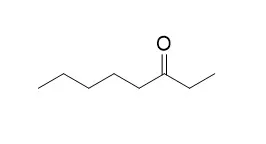| In vitro: |
| Journal of Agricultural & Food Chemistry, 1991, 39(12):1551-7. | | Volatiles mediating plant-herbivore-natural enemy interactions: soybean looper frass volatiles, 3-octanone and guaiacol, as kairomones for the parasitoid Microplitis demolitor.[Reference: WebLink] |
METHODS AND RESULTS:
Female Microplitis demolitor (Wilkinson) (Braconidae: Hymenoptera) were attracted to Tenax-trapped volatiles from the larval frass of soybean looper, Pseudoplusia includens (Walker) (Lepidoptera: Noctuidae), produced on the foliage of looper-susceptible Davis and looper-resistant PI 227687 soybeans and host Henderson lima beans, in an olfactometer. Linalool (3,7-dimethyl-1,6-octadien-3-ol), guaiacol (2-methoxyphenol), and 3-Octanone were identified as major components of such frass volatiles by GC-MS analysis. These compounds were not detected in the volatiles of frass produced on an artificial diet. Such volatiles produced on the artificial diet were not attractive to the parasitoid. Authentic samples of 3-Octanone and guaiacol were attractive to female M. demolitor in olfactometer tests. These two compounds also elicited higher EAG responses in female M. demolitor than linalool and cis-3-hexen-1-ol. The quantity of guaiacol in the soybean looper frass produced on PI 227687 was higher (ca. 5 times) than on Davis soybean or lima bean leaves. 3-Octanone was detected in the volatiles trapped from excised foliage of Davis and excised foliage and intact plants of PI 227687 soybeans. Guaiacol and linalool were not detected in soybean foliage volatiles.
CONCLUSIONS:
The significance of volatiles in the host-seeking behavior of M. demolitor, the tritrophic interactions among plants, herbivores, and natural enemies, and the role of herbivore frass volatiles in maintaining the natural enemy's host specificity are discussed. | | Journal of Chemical Ecology, 1991, 17(3):581-597. | | Fungal volatiles: Semiochemicals for stored-product beetles (Coleoptera: Cucujidae).[Pubmed: 24258808] |
METHODS AND RESULTS:
Responses by five species of cucujid grain beetles (mixed-sex adults) to various volatiles were assessed by means of a two-choice, pitfall olfactometer. The test volatiles were short-chain alcohols and ketones known to be produced by fungi. Both racemic and chiral 1-octen-3-ols were strong attractants for Cryptolestes ferrugineus (Stephens), as had been found previously for Oryzaephilus surinamensis ( L. ), O. mercator (Fauvel), and Ahasverus advena (Waltl). 3-Methylbutanol was another good attractant for these four cucujids, and it was the only test compound to which Cathartus quadricollis (Guér.) responded positively.
CONCLUSIONS:
1-Octen-3-one, racemic 3-octanol, and 3-Octanone showed various degrees of attractiveness for the former four species of cucujids. O. surinamensis was the only species of test beetle to show much positive response to 2-phenylethanol and ethanol. For O. mercator and O. surinamensis , 3-methylbutanol enhanced positive response to their respective cucujolide aggregation pheromones. |
|






 Cell. 2018 Jan 11;172(1-2):249-261.e12. doi: 10.1016/j.cell.2017.12.019.IF=36.216(2019)
Cell. 2018 Jan 11;172(1-2):249-261.e12. doi: 10.1016/j.cell.2017.12.019.IF=36.216(2019) Cell Metab. 2020 Mar 3;31(3):534-548.e5. doi: 10.1016/j.cmet.2020.01.002.IF=22.415(2019)
Cell Metab. 2020 Mar 3;31(3):534-548.e5. doi: 10.1016/j.cmet.2020.01.002.IF=22.415(2019) Mol Cell. 2017 Nov 16;68(4):673-685.e6. doi: 10.1016/j.molcel.2017.10.022.IF=14.548(2019)
Mol Cell. 2017 Nov 16;68(4):673-685.e6. doi: 10.1016/j.molcel.2017.10.022.IF=14.548(2019)